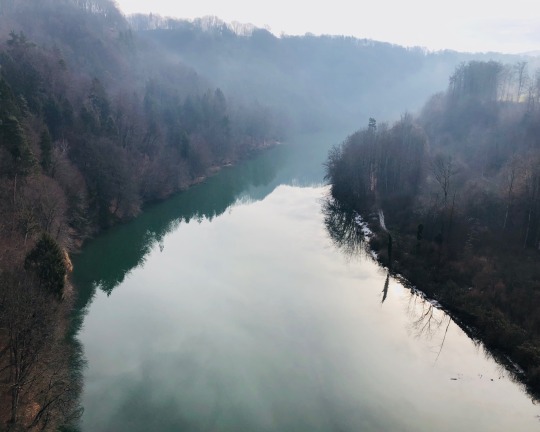#röstigraben
Text
Wednesday 13 November 2002 - the old way past Thun and Spiez across the Berner Oberland - nice day to visit Brig and Sion - exploring Gaillard - evening stroll through Frauenfeld TG
13 November 2002
EN Hi everyone. Twenty years ago today, I took a train tour of the southwest part of Switzerland from Zürich, about as southwest as possible without use of the Glacier trains (Zermatt to Chur), went through the predecessor of the Lötschberg Base Tunnel, Brig, Sion, Geneva, Gaillard in France, and back through Frauenfeld and Zürich. I covered much ground by rail that day.
DE Hallo allerseits. Heute vor 20 Jahren unternahm ich von Zürich aus eine Zugfahrt durch die Südwestschweiz, möglichst südwestlich ohne Benutzung der Gletscherzüge (Zermatt bis Chur), ging durch den Vorgänger des Lötschberg-Basistunnels, Brig, Sion, Genf, Gaillard in Frankreich und zurück über Frauenfeld und Zürich. Ich habe an diesem Tag viel mit der Bahn zurückgelegt.
DK Hej allesammen. For tyve år siden i dag tog jeg en togtur i den sydvestlige del af Schweiz fra Zürich, omtrent så sydvest som muligt uden brug af Glacier-togene (Zermatt til Chur), gik gennem forgængeren til Lötschberg Base Tunnel, Brig, Sion, Genève, Gaillard i Frankrig og tilbage gennem Frauenfeld og Zürich. Jeg dækkede meget jord med jernbane den dag.
SE Hej allihopa. För tjugo år sedan idag tog jag en tågtur i den sydvästra delen av Schweiz från Zürich, ungefär så sydväst som möjligt utan användning av Glacier-tågen (Zermatt till Chur), gick genom föregångaren till Lötschberg Base Tunnel, Brig, Sion, Genève, Gaillard i Frankrike och tillbaka genom Frauenfeld och Zürich. Jag täckte mycket mark med järnväg den dagen.
FR Salut tout le monde. Il y a vingt ans aujourd'hui, j'ai fait un tour en train de la partie sud-ouest de la Suisse depuis Zurich, à peu près aussi au sud-ouest que possible sans utiliser les trains Glacier (Zermatt à Coire), j'ai traversé le prédécesseur du tunnel de base du Lötschberg, Brigue, Sion, Genève, Gaillard en France, et retour par Frauenfeld et Zürich. J'ai parcouru beaucoup de terrain en train ce jour-là.
Guten Morgen! Good morning! Bonjour!
Wednesday 13th November 2002, I would kind of make a tour of the southwest of Switzerland, crossing the so-called Röstigraben and back, and come back to see Frauenfeld in Thurgau, before returning to Zürich. The weather would be quite nice for a November day.
I woke up about 5:30 AM, took a shower, and went down at 6 AM for breakfast. About 6:30 AM I walked to the northern end of the hostel and crossed the street to the trolleybus stop for line 33. The bus 33 came in about ten minutes and I was at Morgental about 6:45 AM. Then I walked around the corner and boarded the tram line 7. I did not get to HB until 7:10 AM. Paradeplatz and Bahnhofvorplatz were not particularly congested, but Rennweg was a bit of a slow spot.
About 7:20 AM I boarded an Intercity train for Bern with intent to transfer to another train to Brig in the canton of Valais, or Wallis as it is called in German. The IC train was a Dosto, a double level train, from 2000. The train arrived at Bern about 8:10 AM. The train to Brig was a single level train, and arrived in Bern about 8:25 AM. I boarded it, and it departed at 8:30 AM. It stopped at Thun and Spiez, as opposed to Interlaken and Lauterbrunnen, before proceeding to the entry to the old Lötschberg tunnel. There was a plan to build a tunnel that was lower in elevation, but that did not start until 2007. That made the journey take about two and a half hours before the train arrived in Brig, after passing by Visp, about 11 AM. That would be just before lunchtime.
Brig is the last stop for regular rail travel, especially with the Swiss Pass, in Switzerland, before taking the Glacier Train to Chur. An extra fare is required for the Glacier Train. When the Eurail Pass was valid, that also was true. From Brig, most other trains went to Iselle, Domodossola and Milan and beyond. I had been to Brig in April 2001, while on the way to Milan, but just to wait to change locomotives. This time, I would properly explore Brig.
I walked from the Brig rail station to Ueberlandstrasse to Glismattenstrasse, and then Gliserallee, back into downtown. The weather in Brig was sunny, temperatures in the low 50s, about 10 to 12 Celsius. In a way, downtown Brig kind of looked like downtown Lugano but with a more German style, and much less traffic.
I was about ready to leave Brig for Geneva, but needed some food. I went to the Migros next to the rail station and bought some food and soft drinks as I did not want to have beer just yet. Then I boarded the train to Geneva, which was just a simple mid-1990s single level Intercity train. The train had German-language next stop announcements up to and including Visp, Leuk and Siders, the German name for Sierre. I was listening to the Nick Straker Band play on SRF3, then called DRS3, and then towards the end of the song, the annoucement that the train was arriving in Siders / Sierre was on the loudspeakers. At this stage, we were close to crossing the Röstigraben westward towards Sion, Lausanne and Geneva. One last song I remembered on that ride, was hearing "Häbs güet" by a then-unknown band from the canton of Bern, called Plüsch, which means plush, as in a stuffed animal or similar.
After crossing the Röstigraben in Siders, the train went along to Sion, the cantonal capital of Valais. It is called Setten in German. I decided to alight from the train and then explore a little bit of Sion. I went north along Avenue de la Gare for ten minutes and went back to the station. I think it would have been 2 PM, before I boarded the next train to Geneva. The train stopped in Martigny, the last stop on that route in Valais, then St. Maurice in Vaud, Montreux, Vevey, Lausanne, Morges, Nyon and Genève, but not Sécheron near Parc Mon Repos. The train arrived about 3:30 PM, and then clouds started to appear, but it was not so bad. I bought a day pass for the TPG, or the transport agency for Geneva. I could take the tram to the stop Moillesullaz and walk across the border into France at Gaillard. I had to take a tram from the rail station to Bel Air, and transfer to the line 12. At Moillesullaz in the Graveson district of Thônex GE, there is a tram turnaround loop, and the crossing is only fifty feet away. The douanniers were concerned mainly with the auto travellers and less with pedestrians. I was able to walk on D-1205 / Rue de Genève, up to the intersection of Rue Marcel Degerine. This was about the same location as the Appart-City Gaillard which I stayed at from 6th to 8th December 2016 (the same time that I did my first "Oh li'l Gizzy, whatcha doin'?" video in Annecy). At the SPAR grocery store nearby, I bought some Pétrole Hahn shampoo to take back home. That was the same shampoo that I first used on 26th March 2000 while visiting Paris.
I walked back to the Moillesullaz tram stop. I did not have much to declare, and I had only enough shampoo for my personal use. I boarded the line 12 for Bel Air Cité, walked to the flower clock and also was able to see the Jet d'eau before it was shut off for the season. Then I took another tram back to the rail station. The sun was about to set, I think around 5 PM, and the streetlights were just turning on. I went back to the rail station and boarded a 5:30 PM train for Zürich via Biel (crossing the Röstigraben once more), Olten and Aarau, before terminating at Zürich HB. The ride took about two hours, arriving around 7:45 PM in Zürich HB. I found a train to Winterthur and another to Frauenfeld in Thurgau. I had previously only visited Thurgau by riding through St. Gallen into Winterthur. I was on an Interregio train to Frauenfeld which would terminate at Kreuzfeld at the border with Germany, next to Konstanz. Frauenfeld was not a large city, so there was not much to see, especially about 9 PM. The local S15 train was still running, and I rode it one way past the castle Schloss Frauenfeld to Marktplatz, but walked back from Marktplatz. There was one traffic signal to note there, at Marktstrasse and St. Galler Strasse, as if it were the only one in the entire canton of Thurgau, it turns out that it is not the only one.
I boarded the train back to Zürich via Winterthur, about 9:40 PM. The tram line 7 was still running to Morgental, and trolleybus 33 still as well. I took those back to the hostel, went to bed and slept until the next morning. Please join me when I visit Chur, have some ice cream for half price as it is off season, take a ride to the Escher Wyss Platz and see the location of the Hardhof, then we have supper at the Zeughauskeller. Hope you will join me then!
Gute Nacht! Good night! Bonne nuit!
#Zürich HB#Bern#SBB#Thun#Spiez#Lötschberg#Lötschberg Base Tunnel#Visp#Brig#Valais#Wallis#VS#Siders#Sierre#Röstigraben#Sion#Setten#St. Maurice#Martigny#Lausanne#vd#Genève#Geneva#Gaillard#Jet d'Eau#flower clock#biel#Frauenfeld#Thurgau#TG
2 notes
·
View notes
Text
29.12.2022 | Biel Seevorstadt | 16.15h
Das Museum sei aber nur bis 17 Uhr geöffnet, sagt die Frau an der Kasse, und es gebe doch so viel zu sehen, die Ausstellung über den Röstigraben und die über die Stadtgeschichte, die Industrialisierung und die berühmten Künstler und neu auch eine Sonderausstellung über Saisonniers. Ja, der junge Mann werde uns die Wohnung zeigen, dieser Teil des Museums sei nur auf Wunsch offen, ja.
0 notes
Text
i love seeing talks about regionalism on my dash cause they reminded me that here you can drive for 30 minutes and the people around you speak a language from a whole different language family
9 notes
·
View notes
Photo

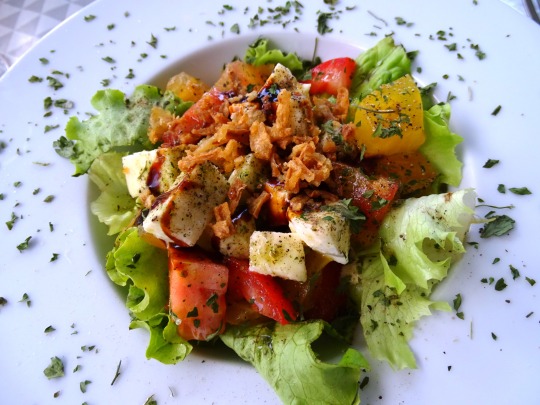

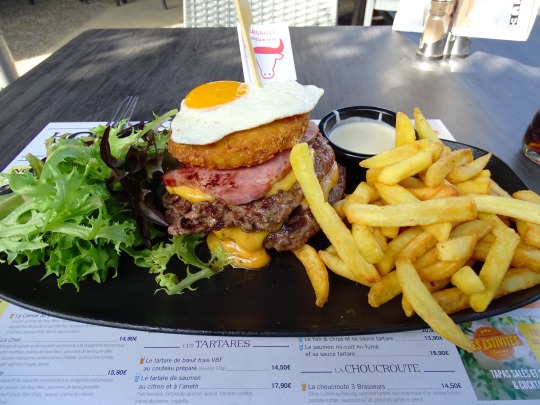
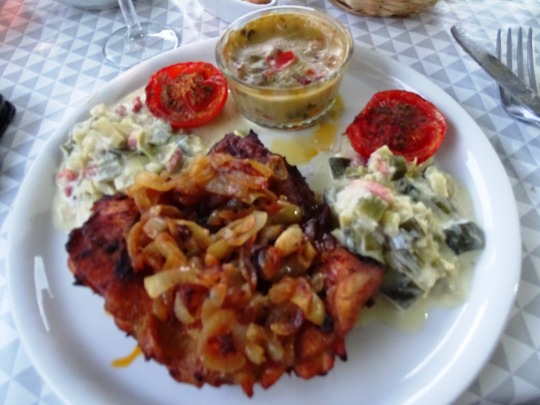

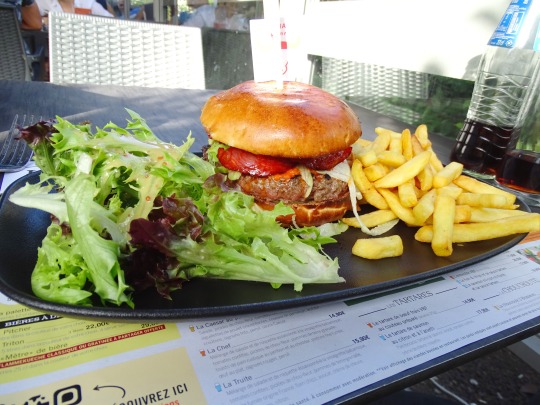
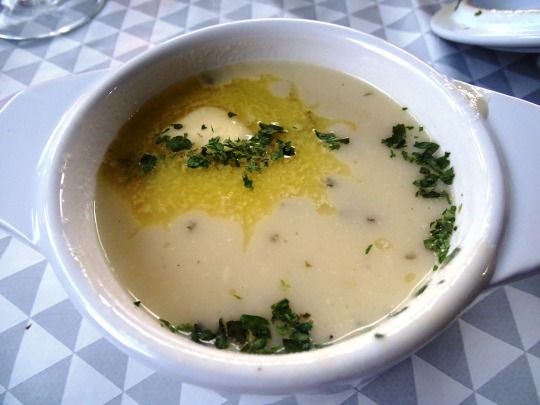
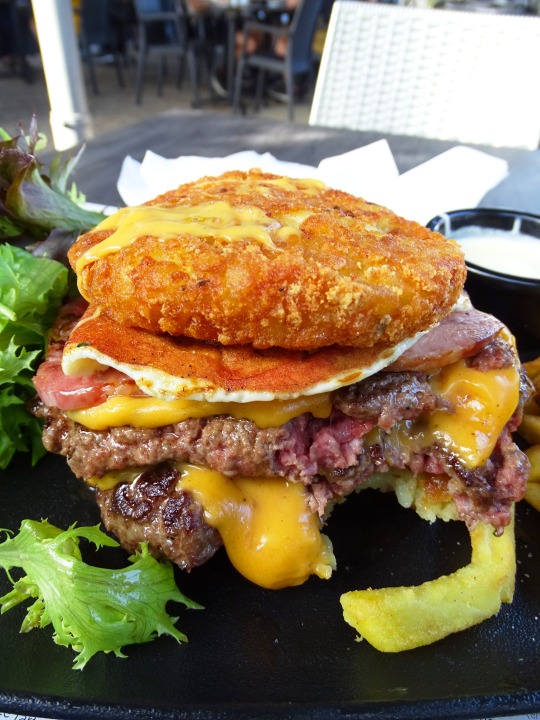
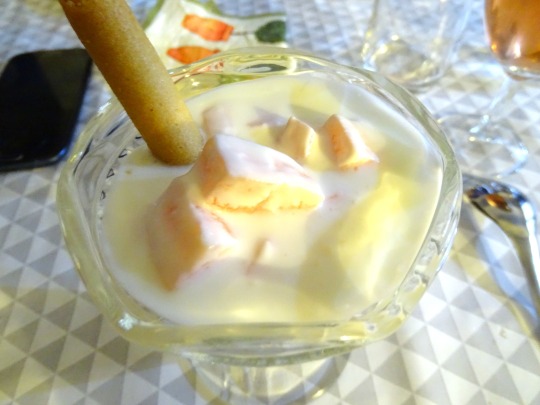
Food in France
Rösti is a Swiss dish consisting mainly of potatoes, in the style of a fritter. It was originally a breakfast dish, commonly eaten by farmers in the canton of Bern, but is now eaten all over Switzerland and around the world. The French name röstis bernois makes direct reference to the origins of the dish.
Many Swiss people consider rösti to be a national dish. Rather than considering it a complete breakfast, lunch or dinner, it is more commonly served to accompany other dishes such as Spinat und Spiegelei (spinach and fried eggs, sunny side up), cervelas or Fleischkäse. It is commonly available in Swiss restaurants as a replacement for the standard side dish of a given meal.
Rösti dishes are made with coarsely grated potato, either parboiled or raw. Rösti are most often pan-fried and shaped in the frying pan during cooking, but they can also be baked in the oven. Depending on the frying technique, oil, butter, cheese, or another fat may be added (and usually salt and pepper). The grated potatoes are shaped into rounds or patties, usually measuring between 3 and 12 cm (1 and 5 in) in diameter and 1 and 2 cm (0.4 and 0.8 in) thick.[citation needed]
Although basic rösti consists of nothing but potato, a number of additional ingredients are sometimes added, such as bacon, onion, cheese, apple or fresh herbs. This is usually considered to be a regional touch.
In Palau, instead of potato, rösti is prepared from the grated corm of taro.
In Swiss popular cultural ethos, rösti are predominantly eaten in German-speaking regions, although they can be found easily elsewhere in the country. Rösti dishes are portrayed as a stereotypical part of the Swiss-Germanic culture, as opposed to Latin culture. The geographic border separating the French- and German-speaking parts of the country is therefore commonly referred to as the Röstigraben: literally the "rösti ditch".
Source: Wikipedia
#Chorizo Pizza#Pizza Indienne#Le Country Burger#Rösti#egg#salad#fries#Colombe#Nîmes#France#Le Sud Burger#olive#peanut#rosé wine#cocktail#chicken#potato soup#dessert#entrée#appetizer#Swiss dish#Rösti instead of buns#Europe#travel#vacation#summer 2021#don't drink and drive#food#restaurant
5 notes
·
View notes
Audio
(Daniel De Sol I Kombinat✪Sternradio)
Downtempo Stern⭐cast by @djmatija
☁️ SoundCloud: https://soundcloud.com/danieldesol/downtempo-sterncast-by-matija
🍏 Apple Podcast: https://podcasts.apple.com/de/podcast/downtempo-stern-cast-by-matija/id1538672164?i=1000521824132
📊 Deezer: https://deezer.page.link/ecqTYqTuFysd24KZ6
🟥 YouTube: https://www.youtube.com/channel/UCYYaqHQwkhCWHbiZsnbZgUw
☁️ SoundCloud: https://soundcloud.com/danieldesol/
Stern⭐cast (#Sterncast) https://soundcloud.com/danieldesol/sets/hi-here-my-new-podcast-on-new
social media links: www.facebook.com/djmatija www.instagram.com/matija.sound/
playlist: DownCast
1. Matija & Richard Elcox - A Lama With No Name
2. Alvaro Suarez - Luces Y Sombras
3. Omeria - Evvela
4. Angata - Ga'agua feat. Yohana
5. Dani Posada - Maria
6. Bahramji & Medusa Odyssey - Jana
7. Turu Anasi - Meditation (Okuma Remix)
8. Narcisse (Mex) - Prime Time Catastrophe
9. Sangeet - Anaya
10. Jose Solano - Sahar
11. Alex Twin & VICTHOR - Amarr
Matija is a well-travelled gentleman:
From the Swiss province, where he took his first (and second) musical steps, he was drawn to the street jungle of the German capital Berlin, where he stayed for 6 years and deepened his craft. Together with his then roommate Dave Dinger, he moved around the houses and rocked clubs like Bar25 etc. with him. And if you make it in Berlin, you take little Zurich by storm: Matija set out to conquer the Swiss scene metropolis after his return. With success: After party series in the supermarket, Hive (and other clubs) he worked for years as a night manager in the Zurich Hive Club and still continues to play in this one as a resident. As a former night manager of Gonzo, Frieda's Büxe and Hive, he has now been on the road as a DJ for 24 years throughout Switzerland and often internationally, among others with Dave Dinger. With his sets he always provides that certain
treat on the dancefloors. Festivals Fusion / Garbicz / Vision / Lethargy / Schatzalp / Zug der Liebe / Streetparade / Chocolate Festival / Break Da Röstigraben Festival / Festival Des Arcs / One Love / Badenfahrt / Züri Fäscht / Burning Mountain / Rakete / Takt am See / Zuflucht / Château des Fous / Captain's Rave / Arosa Electronica
1 note
·
View note
Photo
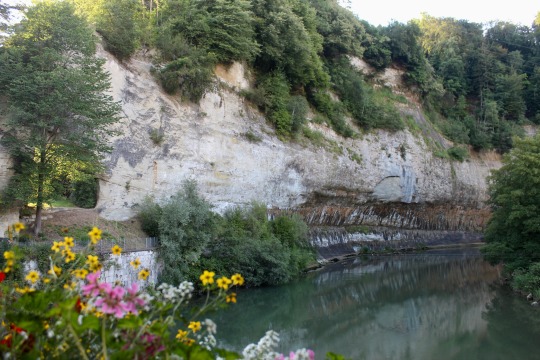
Avant de quitter Fribourg, je fais une promenade au bord de la Sarine qui marque la limite du Röstigraben* (le “fossé des Röstis”) différence culturelle entre la Suisse alémanique (germanophone) et la Suisse romande (francophone)
* ( Cette expression apparait durant la première guerre mondiale).
Enfin, les Röstis sont également une galette de pomme-de-terre typique de la Suisse alémanique !
1 note
·
View note
Photo
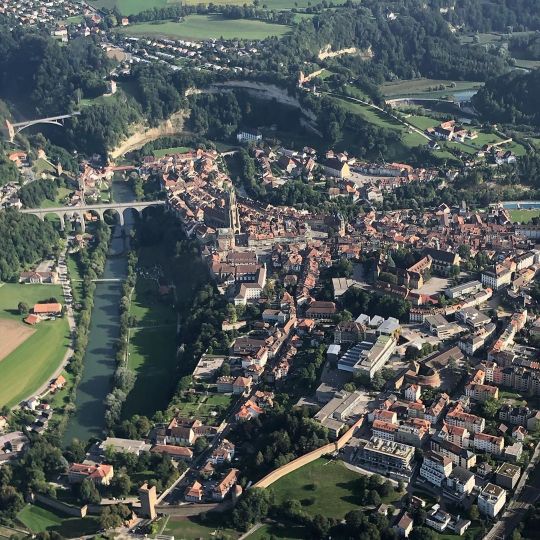
Röstigraben from 4200 feet high https://www.instagram.com/p/B8MxeP-nVTL/?igshid=1hxmyosl3eg8p
1 note
·
View note
Photo
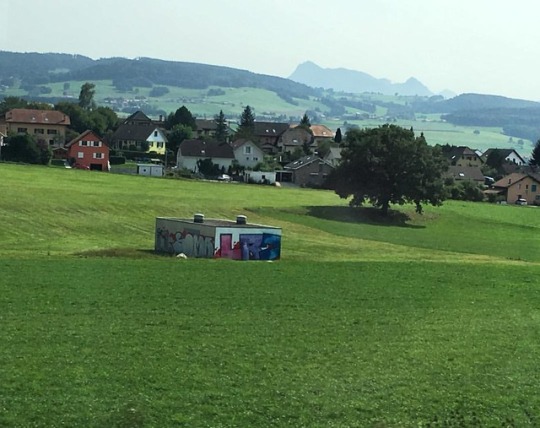
#traintrip #graffiti #streetart #betweenbulleandfribourg #cantondefribourg #frenchspeaking #germanspeaking #röstigraben (at Romont région)
#frenchspeaking#cantondefribourg#traintrip#betweenbulleandfribourg#graffiti#röstigraben#streetart#germanspeaking
0 notes
Audio
Le service public, c'est bien utile et nécessaire !
En 2010 j'avais contacté la rubrique "au milieu du village" de la radio (nationale ) Couleur 3 afin qu'ils viennent me rendre une petite visite. À l'époque, chaque jour, un village romand était présenté sous un angle particulier, j'ai saisi l'opportunité de leur parler de ma vie dans une commune située du côté germanophone de la fameuse "barrière des röstis" ! J'ai retrouvé le fichier MP3 que je partage ici avez-vous ! Pour les « insiders » vous reconnaitrez sous mon personnage, la voix de Vincent Kucholl, devenu célèbre en Suisse romande entretemps grâce à sa rubrique « 120 secondes »,à son spectacle et à son émission TV (avec son complice Vincent Veillon).
0 notes
Note
You have the southern lingo down. So how long did you live in the south and where? I love Switzerland so much. Tell me something interesting that most don’t know. And don’t tell me neutral either 😜😂
I actually never lived in the south! When I moved to LA after college my roommates at the time were from New Orleans and Houston respectively and so I picked up on “y’all” and “I’m fixing to” and my personal fave, “bless his/her/their heart”. They’re both still really good friends of mine and it’s just kind of stuck.
As for me, I’m from a town on the linguistic border between French-speaking and German-speaking parts of the country (Röstigraben, represent!). Though to my grandparents great shame, I’m better at English 🙃
8 notes
·
View notes
Text
Sunday 3 August 2003 - Fribourg to Düdingen FR - crossing the Röstigraben at least twice - night train to Ljubljana - first visit to the former Yugoslavia - the beginning of the horrible heat dome - evening along the Ljubljanica
Sunday 3 August 2003 + Monday 4 August 2003
Good morning! Today we will spend a little time in the Suisse Romande before going to catch the night train in Zürich to Ljubljana. We spend a little time in Lausanne before going to Fribourg and Düdingen, to see what life is like on both sides of the Röstigraben. In Zürich we catch the night train that goes to Ljubljana, passing through Liechtenstein, Tirol including Innsbruck and Wörgl, Villach, Jesenice and Bled. It will be the first time that I visit the former Yugoslavia but not the last time. Hope you will enjoy today's adventure.
Guten Morgen! Heute verbringen wir ein wenig Zeit in der Westschweiz, bevor wir in Zürich den Nachtzug nach Ljubljana nehmen. Wir verbringen ein wenig Zeit in Lausanne, bevor wir nach Freiburg und Düdingen fahren, um zu sehen, wie das Leben auf beiden Seiten des Röstigrabens ist. In Zürich nehmen wir den Nachtzug, der nach Ljubljana fährt und durch Liechtenstein, Tirol inklusive Innsbruck und Wörgl, Villach, Jesenice und Bled fährt. Es wird das erste Mal sein, dass ich das ehemalige Jugoslawien besuche, aber nicht das letzte Mal. Ich hoffe, Sie werden das heutige Abenteuer genießen.
Bonjour! Aujourd'hui, nous passerons un peu de temps en Suisse romande avant d'aller prendre le train de nuit à Zürich pour Ljubljana. Nous passons un peu de temps à Lausanne avant d'aller à Fribourg et Düdingen, pour voir à quoi ressemble la vie de part et d'autre du Röstigraben. À Zürich, nous prenons le train de nuit qui va à Ljubljana, en passant par le Liechtenstein, le Tyrol, y compris Innsbruck et Wörgl, Villach, Jesenice et Bled. Ce sera la première fois que je visiterai l'ex-Yougoslavie mais pas la dernière fois. J'espère que vous apprécierez l'aventure d'aujourd'hui.
Dobro jutro! Danes bomo preživeli nekaj časa v Suisse Romande / Zahodna Švica, preden bomo ujeli nočni vlak v Zürichu za Ljubljano. Nekaj časa preživimo v Lausanni, preden gremo v Fribourg in Düdingen, da vidimo, kakšno je življenje na obeh straneh Röstigrabna. V Zürichu ujamemo nočni vlak, ki pelje proti Ljubljani, pelje čez Liechtenstein, Tirolsko vključno z Innsbruckom in Wörglom, Beljak, Jesenice in Bled. To bo prvič, da bom obiskal nekdanjo Jugoslavijo, vendar ne zadnjič. Upam, da boste uživali v današnji avanturi.
Dobro jutro! Danas ćemo provesti malo vremena u Suisse Romande / Zapadna Švicarska prije nego što u Zürichu uhvatimo noćni vlak za Ljubljanu. Provodimo malo vremena u Lausannei prije odlaska u Fribourg i Düdingen, da vidimo kakav je život s obje strane Röstigrabena. U Zürichu hvatamo noćni vlak koji vozi za Ljubljanu, prolazi kroz Lihtenštajn, Tirol uključujući Innsbruck i Wörgl, Villach, Jesenice i Bled. Bit će to prvi put da posjećujem bivšu Jugoslaviju, ali ne i zadnji put. Nadam se da ćete uživati u današnjoj avanturi.
Buongiorno! Oggi trascorreremo un po' di tempo nella Svizzera Romanda / Svizzera occidentale prima di andare a prendere il treno notturno da Zurigo per Lubiana. Trascorriamo un po' di tempo a Losanna prima di andare a Friburgo ea Düdingen, per vedere com'è la vita su entrambe le sponde del Röstigraben. A Zurigo prendiamo il treno notturno che va a Lubiana, passando per Liechtenstein, Tirolo comprese Innsbruck e Wörgl, Villach, Jesenice e Bled. Sarà la prima volta che visito l'ex Jugoslavia ma non l'ultima volta. Spero che apprezzerai l'avventura di oggi.
I had much fun the previous day in Geneva. It was my first parade since the one in August 1998, but with a bit of francophonic flavor. There was still a bit yet to visit, particularly Fribourg, which I had visited in 2001, but only to change trains. I had previously visited Neuchâtel in April 2001 as well, so there was no point in going there this time. As I did not know if Fribourg had proper lockers, I decided to place my luggage in Lausanne, where I knew there still were proper working lockers.
I had breakfast about 7:30 AM, and was ready to check out by 8:30 AM. I took the bus from the hostel to Territet station, took the westbound REV to Lausanne, and deposited my rolling suitcase. I had a look around the station. The cog rail system that I remembered from 2000 and 2001, had been shut down. This was because the local public transit company wanted to replace the cograil system with a bidirectional adhesive system using MP89-like cars. I would return in February 2012 to ride it.
After looking around the Gare CFF Lausanne, I took a train to Fribourg, which was a SBB Dosto, or double level quality train pulled by a premium electric locomotive, similar to the ones I rode in September 2000 and November 2002. It did not stop in Vevey, but went up the REV S5 and S6 routes to Puidoux VD, Moreillon VD, Palézieux, Oron, crossing into the Fribourg canton, Romont, Villars sur Glâne and Fribourg. I exited the train at Fribourg. Fribourg has a connection to the Bern S-Bahn system, which has a stop in Düdingen, which I would visit sometime later in the afternoon. I walked along Boulevard des Pérolles. As it was a Sunday, shops were closed, so I could only do "leche vitrine", or window shop. The day was fairly nice, not too warm, maybe +27 C / 80 F. I found a place to eat after walking a while. I had a lunch portion of pasta with a Cardinal beer. It tasted almost like a Feldschlösschen or an Eichhof.
After lunch, I walked back to the rail station, and boarded the S-Bahn for Düdingen. At the time, the Poya rail station was not yet built, so the next station from Fribourg CFF was across the Schiffenensee in Düdingen. The Schiffenensee was also considered the local Röstigraben, crossed by the Viaduc de Grandfey. Across the Schiffenensee, everything changed from French to German. Soon enough, the train stopped in Düdingen. I first passed through Düdingen about 11:30 AM on Sunday 10th September 2000, while going from Lausanne to Zürich, not knowing if it were in the canton of Bern, or still in Fribourg. Fribourg is mostly a French-speaking canton, but it has some communities that speak German. The Röstigraben generally does not follow cantonal boundaries. Even the Polentagraben follows the Uri-Ticino cantonal boundary, but when it comes to Graubünden, that is a different story. The canton of Wallis and to some degree also Neuchâtel, are mainly French-speaking, also with German-speaking towns closer to Bern. I did not speak with many people in Düdingen, but I suspect their dialect of German would follow that of Bern.
In Düdingen I walked sort of northeast of the SBB rail station. I walked along the Hauptstrasse to see the Saatzucht Genossenschaft Düdingen silo, where they grow agricultural seeds. Düdingen is not particularly large, but it is a notable town, in my opinion. On a Sunday there was not much going on. I decided to return to Fribourg and catch the next train to Lausanne, fetch my luggage and take the next Inter City train to Zürich. Before I did that, I went into the Kiosk store, on the Düdingen SBB station premises, and ordered myself a chocolate ice cream on a stick, I think a Magnum white chocolate. It was really good, just right for summer. When I finished that, I waited for the next S-Bahn train to Fribourg. The train to Lausanne was not quite at the station, so I looked around. I found a payphone that took not just Swiss Francs, but also Euro. Normally Swiss phones take only Francs, but the one I saw, had a blue and yellow "€" sign with the familiar twelve yellow stars.
I took the next fast train to Lausanne. It was a Dosto and travelled nonstop. At Lausanne CFF, I fetched my rolling suitcase, and walked to the platform where the next train to Zürich would leave from. I found a Dosto. I sat in the lower floor of the first class compartment for the quietness. The upper level is a bit noisier, and also has the Elvetino rail bar rolling through at times. It was a nice quiet ride to Zürich.
In Zürich, I would have at least an hour layover until the train would be ready to board. I had my reservation with me. I would be sleeping in the lowest bunk of a three person car. The train would go through, but not stop everywhere, southwest of the Lake Zürich, Pfäffikon SZ, Ziegelbrücke, Sargans, Schaan FL, Feldkirch, Bludenz, Innsbruck, Wörgl, Salzburg, Zell am See, Villach, Rosenbach, Jesenice and finally Ljubljana, and then on to Zagreb. I walked with my rolling suitcase to the bridge to Central and the north end of Niederdorferstrasse where the bottom station of the Polybahn to ETH Zürich is located. I had a look at the Limmat south to Bellevue and Lake Zürich, but did not walk there at that time. From 8th to 11th August, I would spend more time in Zürich, so I decided to not take too much time, and to be ready for the train to leave.
At the rail station, the train had arrived about 7:30 PM local time. I found my car, and showed the reservation to the conductor. He showed me to my compartment, and I was on the lower bunk. He took my ticket and passport, and he said he would return it after we cleared Slovenian customs. He would also put entry and exit stamps as appropriate. The compartment had three people on a three bunk bed setup. There was a sink in the room. The toilet would be down the hall. Meals were not included, so it was a good thing that I had some food before boarding, and I also had leftover bottles of grapefruit soda and similar. I was not so interested in carrying around much beer. The train left about 8:30 PM.
After the train left at 8:30 PM, it went on its route on the south end of the St. Galler Oberland mountains, crossed the Rhine at Buchs into Liechtenstein at Schaan, just north of Vaduz, then through Feldkirch, Bludenz, Innsbruck, Wörgl, Salzburg, Villach and Rosenbach. Much of the night, the train was moving about 75 mph or 120 km/h at most. Sleeping was kind of like I was lying down but being pulled in one direction. It felt similar to when I went on 11th November 2002, from Hamburg Hbf to Zürich HB, arriving on 12th November.
About 6 AM, the train pulled into Villach, in the Bundesland of Kärnten. The sun had risen sometime while we passed through Spittel an der Drau. This would be the only time I would be awake to see Austria that year. This would be a major stopping station for the train. Some people would exit the train, some would board it. The train would make one last stop in Austria, at Rosenbach. I received a stamp in my passport before departing for Slovenia. About 8 AM, the train would be in Jesenice, Slovenia. At Jesenice, the customs officials checked passports, and gave me an entry stamp. This was my first entry into Yugoslavia. The train went on to Ljubljana through really nice countryside, including Bled and Kranj.
About 9 AM, the train arrived in Ljubljana, at Glavni Stanica. In 2003, in Slovenia, although it had ascended to the European Union, it was neither a user of the Euro, nor was it part of the Schengen Agreement. Instead, Slovenia used the Tolar, which was about 110 Tolar to the US Dollar. I had to withdraw some money to be able to buy basic items. I think the highest valued money I had was a 1,000 Tolar bill. There did not seem to be any subdivisions of the Tolar that I was aware of, no coins under 5 Tolar were used. In 2008, Slovenia started using the Euro. In 2022, Croatia followed suit, using the Euro and being part of the Schengen Agreement.
At the station, I found the bus station, and bought myself a bus pass for the entire day, which would give me unlimited bus rides all around the city. The youth hostel was not particularly far away, it was called Dijaski Dom Tabor, along Kotnikova Ulica. It did not seem too far to walk from the station, but by the time I walked all the way, I was very tired. The hostel had its familiar blue on white Hostelling International logo, and the door had "Dijaski Dom Tabor" on the top. I checked into the hostel, and my room was ready. My room was a double room but no one other than myself was booked for that room for the two days I would stay. I took a shower and changed clothes in the private bathroom, then I was ready to take the bus into town.
The traffic lights in Slovenia are not particularly special. They are mostly large head signals, about 12 inches or 300 mm per head. At the time, they performed R-RY-G-Y similar to Switzerland and Germany, but there was a period of three flashes of green before going yellow. I doubt that in 2023 that the signals do that anymore, but merely do the same sequence as Germany. To get to downtown, I had to walk to Komenskega ulica, and board the bus at the 3 Illirska ulica bus stop. I went as far west on the bus as Tivolska Cesta and south into the city. Eventually I ended up about 3 PM that day in the cathedral square at Cankarjevo nabrezje. That is the old town and major shopping center for Ljubljana. The castle is high on the hill nearby. It was neat to see the canal containing the Ljubljanica river. I would visit there later that evening.
About 3 PM I was starting to feel a bit of heat stroke. I think it was a mistake to book a very cheap room at the hostel, particularly in that part of Europe. I had to go back to the hostel and take a nap. This was kind of like the 20th/21st June 1998 when I was in Salzburg, it was a particularly hot weekend. In 2003 on the other hand, there would be about five days of hot weather, which would not let up until I went on to Munich, after visiting Zürich.
I left the hostel about 6 PM when the weather cooled down a bit. I took the bus into town, across the Mesarki Most across the Ljubljanica. I walked around the Giril Metodov Trg to find a nice place. I found one restaurant with an interesting menu. Sadly I only remember the beef tongues with dijon mustard that I had as an appetizer. I don't think I had the cevabcici. At the restaurant, there was a guitar player playing live. One song I remember him playing, was "Pandajero" by Cantoma. I did not know that song at the time, and it would not be until November that year, that I would actually hear it on the radio. Somewhere I still have that recording on an audio cassette.
After supper, I did a bit more walking around the Preseren monument and eastward along the Ljubljanica. The sun had set about 9:30 PM, so the weather was a bit more comfortable. The youth hostel was not too far that I could not walk there on foot. When I was back in the youth hostel, I took my radio and recorded a few hours of Slovene radio. Slovene radio at the time contained international music, including some songs from Italy, but mostly English.
Please join me tomorrow, when I check out the timetables for Milan via Venice, have an encounter with the local Jehova's Witnesses trying to sell me a copy of "Vatchtover" [sic], take the train to Zagreb, ride the tram across town, find a place to eat pizza, return to Trg Republika, take the train back to Ljubljana about sundown, and sleep until 1 AM. Hope you will join me then. Good night!
Bitte kommen Sie morgen zu mir, wenn ich mir die Fahrpläne für Mailand über Venedig anschaue, eine Begegnung mit den örtlichen Zeugen Jehovas habe, die mir ein Exemplar von „Vatchtover“ [sic] verkaufen wollen, mit dem Zug nach Zagreb fahre, mit der Straßenbahn quer durch die Stadt fahre, Suchen Sie sich einen Ort zum Pizzaessen, kehren Sie zum Trg Republika zurück, nehmen Sie gegen Sonnenuntergang den Zug zurück nach Ljubljana und schlafen Sie bis 1 Uhr morgens. Ich hoffe, Sie kommen dann zu mir. Gute Nacht!
S'il vous plaît, rejoignez-moi demain, quand je vérifierai les horaires de Milan via Venise, que j'aurai une rencontre avec les Témoins de Jéhovah locaux essayant de me vendre une copie de "Vatchtover" [sic], que je prendrai le train pour Zagreb, que je prendrai le tram à travers la ville, trouvez un endroit pour manger une pizza, retournez à Trg Republika, prenez le train pour Ljubljana vers le coucher du soleil et dormez jusqu'à 1 h du matin. J'espère que vous me rejoindrez alors. Bonne nuit!
Prosim, pridruži se mi jutri, ko bom preverjal vozne rede za Milano prek Benetk, se srečal z lokalnimi Jehovovimi pričami, ki mi poskušajo prodati izvod "Vatchtover" [sic], šel z vlakom v Zagreb, se vozil s tramvajem čez mesto, najti pico, se vrniti na Trg republike, se z vlakom vrniti v Ljubljano pred sončnim zahodom in spati do 1. ure zjutraj. Upam, da se mi boš takrat pridružil. Lahko noč!
Molim te, pridruži mi se sutra, kada budem provjeravao vozni red za Milano preko Venecije, susreo se s lokalnim Jehovinim svjedocima koji mi pokušavaju prodati primjerak "Vatchtovera" [sic], išao vlakom za Zagreb, vozio se tramvajem preko grada, naći mjesto za pojesti pizzu, vratiti se na Trg Republike, sjesti vlakom natrag u Ljubljanu oko zalaska sunca i spavati do 1 ujutro. Nadam se da ćeš mi se tada pridružiti. Laku noć!
Per favore, unisciti a me domani, quando controllo gli orari per Milano via Venezia, incontra i Testimoni di Geova locali che cercano di vendermi una copia di "Vatchtover" [sic], prendi il treno per Zagabria, attraversa la città in tram, trova un posto dove mangiare la pizza, torna a Trg Republika, prendi il treno per Lubiana verso il tramonto e dormi fino all'una di notte. Spero che ti unirai a me allora. Buona notte!
#Switzerland#Suisse#Montreux#Territet#Lausanne#Vaud#Fribourg#Düdingen#Röstigraben#Polentagraben#Dosto#SBB#CFF#FFS#ÖBB#Zürich#Central#Limmat#Sargans#Buchs#Liechtenstein#Vaduz#Feldkirch#Österreich#Schweiz#Kärnten#Villach#Rosenbach#Slovenija#Slovenia
1 note
·
View note
Text

Zürich am Abstimmungssonntag. Das Covid-Gesetz wird am ersten Advent mit 62% Ja-Stimmen deutlich angenommen. Nur in zwei Kantonen findet das Gesetz keine Mehrheit: Appenzell Innerrhoden und Schwyz. Es gibt keinen Röstigraben, jedoch einen Graben der Staatsskepsis quer durch die eher alpin geprägte Schweiz. Die Urkantone, die auch im Sonderbundskrieg gegen den Bundesstaat gekämpft hatten, sind auch heute an vorderster Front, wenn es um die Bekämpfung staatlicher Massnahmen geht.
Zürich, Gemüsebrücke, November 2021.
0 notes
Text
obsessed with how in Swiss German (mostly Bernese) we just take French words and pronounce them in the most Swiss way possible
#'ade merci' is my favourite example of this#like there are some people who say adiöö but usually it's ade#and merci is just pronounced like merrsi#love that#juice we sometimes call jus#but like schüü#swiss german just feels like a parody of both Hochdeutsch and French#swiss stuff#i call it the röstigraben effect
12 notes
·
View notes
Note
(Not from the US Asks) 11, 21 and 29 please :)
11. favourite native writer/poet?
Omg that’s a hard one. At school we tend to read a lot of French and German authors instead of Swiss ones. It’s one of the things about our country: we’re constantly bathed in the culture of our neighbours, who produce a lot more material than we do, and so we tend to admire French or German or Italian artists more than Swiss ones.
A quick googling tells me that I have read a few Swiss authors at school/uni - ironically, more Swiss-German ones than Swiss-French ones, even though I live in the French-speaking part. I enjoyed quite a few of these novels or plays, but I couldn’t say any of them are by favourite authors.
21. if you could send two things from your country into space, what would they be?
A fondue set and a Gruyère/Vacherin fondue mix, obviously. I’m sure it’s absolutely unsafe to eat molten cheese in space (if it’s even physically possible to achieve), but as Swiss people we must try to make fondue everywhere!
(Case in point: we were told that during big end-of-high-school exams we were allowed to bring in food/drink to keep our strength up... so a guy in my class showed up with a camping stove and a fondue set and made a big show of setting it up) (the teacher promptly told him to put it away)
29. does your region/city have a beef with another place in your country?
The Swiss-French part of the country has a beef with the Swiss-German part, which basically arises from cultural differences between the “lazy” Latin part and the “uptight” Germanic part of the country. We actually have an expression, the “Röstigraben” (the Rösti Trench) to represent the separation line between the Swiss-French and Swiss-German parts of the country and the need for people to “choose sides” (even if they live in a bilingual town/city). This problem is made worse because the Swiss-French tend to hate learning German but are forced to because It’s Good For Your CV.
Also, the Swiss German part represents 66% of the population, so if the country is very divided on a subject, they always win at the polls (we vote about 4 times a year). They tend to vote more conservative than the Swiss-French part.
Finally, I want to say that nobody likes my city, which is seen as a snooty, overpriced and boring place full of rude French people. And I love my city, but those people are not wrong. XD
*Rösti is a popular Swiss-German dish, a kind of hash brown.
4 notes
·
View notes
Text
L’Internationale des auteurs-illustrateurs en Romandie et au-delà...
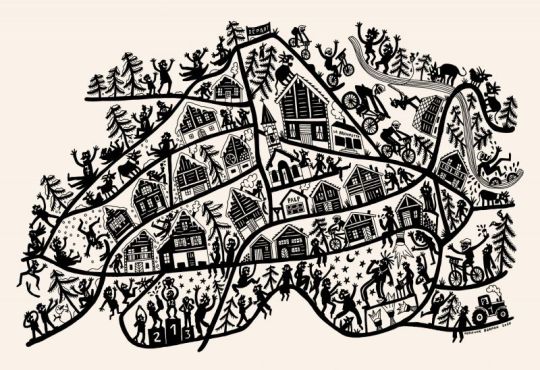
Dessin sur bâche grand format pour le Palp Festival (Bruson) 2021 ©Adrienne Barman
Au début de l’été, La Revue des livres pour enfants, dans son numéro 319, a consacré son dossier à la Suisse. Appelée à renseigner et guider cette découverte, j’y ai également partagé mon expérience en matière de livres jeunesse, bandes dessinées, illustrés et d’un certain “underground”. Une fresque sur fond d’histoire sociale qui ouvre une porte sur le pays. La rédaction et des intervenants suisses et français ont pris la parole pour aborder d’autres thématiques. Aussi, j’ai présenté des artistes dont le travail n’était pas développé ou mentionné ailleurs dans le dossier. J’ai demandé à ce que le choix des illustrations dans mon article en tienne compte. Dans l’article reproduit ci-dessous, les illustrations ne sont pas forcément les mêmes, ni n’illustrent toujours le passage. J’ai également parfois choisi d’insérer des images qui ne sortent pas de livres.
Enfin, pour la clarté de l’article, je n’ai pas utilisé le langage inclusif, même s’il est question majoritairement de femmes. Qu’elles me pardonnent!

Moi Milton ©Haydé Ardalan et La Joie de lire, 1997
En matière d’édition, la Suisse représente un petit marché et ceci d’autant plus que le pays se divise en quatre parties de tailles inégales. Et ses villes accueillent une proportion importante d’étrangers. L’agglomération lausannoise, par exemple, en compte environ 40%. Nous parvenons à vivre en bonne intelligence, mais n’en sommes pas moins clivés. La rivière la Sarine sépare les régions francophones des régions alémaniques. Dans notre vocabulaire, le mot Röstigraben[1] est souvent utilisé. Il fait référence à la séparation entre la partie romande et la partie alémanique et aux différences de culture. Ce fossé qui s’est encore creusé depuis la votation sur l’Espace économique européen en 1992, symbolise également l’opposition politique entre les deux régions. Récemment, un nouveau terme a fait son apparition, le Coronagraben, symbole de notre division sur la gestion de la pandémie. Autre étonnement : la rivière La Versoix formerait une autre frontière entre les cantons de Vaud, plus agricole, et de Genève, laquelle Genève s’est toujours proclamée « république ». Elle serait un peu le « Paris de la France ». Ce pays n’existant pas ou peu, les initiatives locales sont nombreuses et courantes en matière de culture. Comprendre la Suisse, c’est tenir compte de ce tableau, même s’agissant de littérature jeunesse.
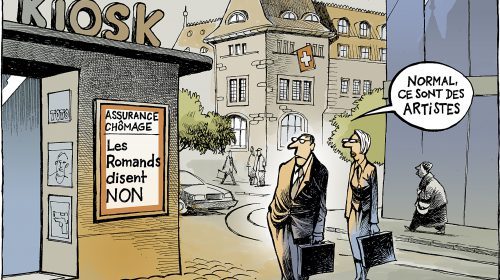


Les Romands vus par les Alémaniques ©Chapatte
Et vice versa... les Alémaniques vus par les Romands ©Philippe Becquelin
Sur la provenance de nos lectures
L’édition romande pour la jeunesse et son illustration ont longtemps brillé par leur absence. Les cantons qui la composent sont restés marqués par l’ombre de Calvin (Genève), la présence bernoise (Vaud), le catholicisme (Fribourg et Valais). Les enfants ont disposé essentiellement d’images vendues par les colporteurs, de lectures à voix haute et d’ouvrages édifiants publiés par des maisons d’édition françaises. Pourtant, au XIXe siècle, il a existé un âge d’or de l’édition romande, mais les livres pour enfants en étaient absents. Au XXe siècle, jusque dans les années 1960, des maisons généralistes en ont publié avant d’y renoncer.
Nos lectures proviennent majoritairement de France. Pour autant, nous avons de bons auteurs publiés par nos quelques maisons d’édition. Il en est de même pour la musique, le cinéma, la télévision et la littérature jeunesse. A cet égard, on citera la Joie de lire et Helvetiq qui publie en français et en allemand.
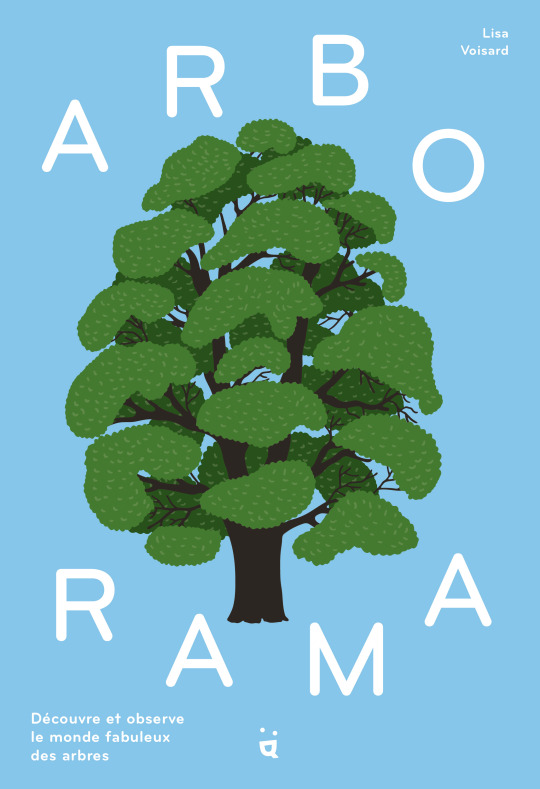
©Lisa Voisard. A paraître chez Helvetiq
La Suisse alémanique nous est étrangère car nous n’avons pas la même culture. Quant aux autres régions linguistiques, il faut traverser le pays et ses montagnes pour les rencontrer. Les livres sont peu traduits d’une région à l’autre et notre connaissance de leurs auteurs n’est que très partielle. Bien sûr, il y existe des passerelles et de l’admiration pour certains auteurs d’outre-Sarine. Citons Alois Carigiet, Hans Fischer, Warja Lavater, Franz Hohler, Jürg Schubiger, Jörg Müller, Hannes Binder, Anna Sommer, It’s Raining Elephants. Il reste que, tout naturellement, nous nous tournons vers le pays voisin.
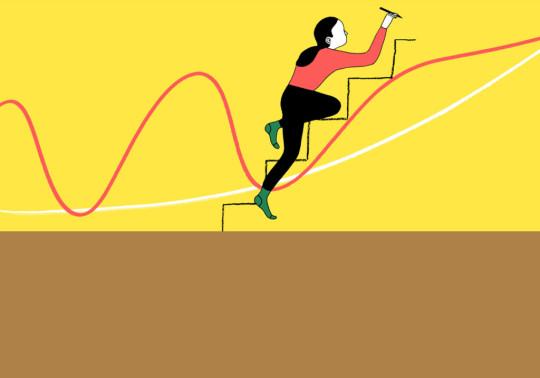
©It’s raining elephants, Covid-19-Newsletter #3, Pro Helvetia, 2020
Dans le vivier de l’illustration
Dans la lignée de Rodolphe Töpffer, considéré comme le premier auteur de bande dessinée occidentale, il y a un côté inventif voire souvent précurseur dans l’illustration romande. En 1951, paraît le premier album de la série des Histoires d’Amadou imaginée par Alexis Peiry et la photographe Suzi Pilet. A une époque où les livres pour enfants sont encore surveillés par les milieux pédagogiques et religieux, le talent de la photographe à expérimenter et créer des mises en scène oniriques offre une ouverture, une bouffée d’oxygène bienvenues. Le couple Peiry-Suzy Pilet a monté sa propre structure, les Editions du Cerf-volant, et assure en partie la diffusion et surtout la promotion. Plus tard, les livres sont publiés en coédition avec Desclée de Brouwer. Aujourd’hui, ils sont réédités par la Joie de lire. Amadou l’audacieux, publié par Infolio en 2013, relate cette aventure.
Etienne Delessert, à la fin des années 1960, se fait connaître aux Etats-Unis, puis en France. Son dessin s’inscrit parfaitement dans cette époque où le livre pour enfants explore de nouveaux territoires. En 1969, les enfants découvrent la bande dessinée Yakari, de Derib, publiée en épisodes dans Le Crapeau à lunettes, magazine créé en 1966 et qui fait suite à L’Ecolier romand. La publication des aventures du petit Indien a son importance puisqu’elle signe l’introduction de la bande dessinée jusqu’alors prohibée par l’école. La voie lui avait été discrètement ouverte par son aîné, le hibou Pythagore, en 1967. Quel saut rien qu’entre les titres des deux magazines ! Cette évolution, on la doit à Derib et surtout au scénariste Job, rédacteur en chef du Crapeau.
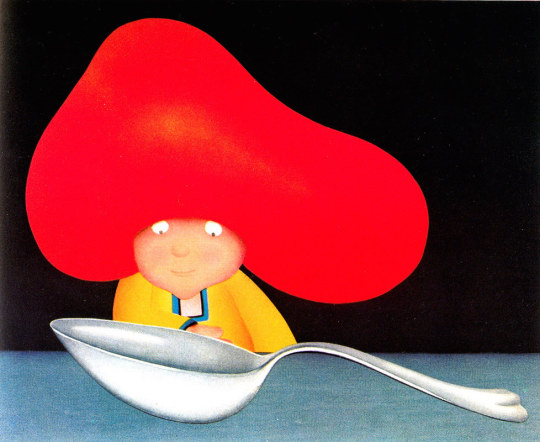
©Etienne Delessert
Les riches heures de l’illustration
Dans les années 1980, Gallimard-Tournesol publie Histoire d’une petite souris qui était enfermée dans un livre, de Monique Felix. Le Yok Yok de Delessert y sera également publié. Jonathan, le nouveau héros de Cosey, fait irruption dans le magazine belge « Tintin ». L’Association romande de littérature pour l’enfance et la jeunesse (Arole), fondée en 1984, défend une littérature de qualité et met en avant d’épatantes illustratrices romandes. Citons Catherine Louis, Béatrice Poncelet – quel choc quand nous découvrîmes Je pars à la guerre, je serai là pour le goûter - et Anne Wilsdorf dont les albums, publiés chez Kaléidoscope, deviennent rapidement des classiques. Ils sont peuplés de gamines espiègles et dotées d’un sacré caractère. Bien qu’universelles, certaines toutefois se prénomment M’Toto ou Jujube, vivent en Afrique et sont noires. Rappelons que dans les années 1990 encore, les livres mettant en scène des personnages noirs et l’Afrique sont rares. Ils offrent un peu de diversité dans un monde essentiellement blanc. Dans ses jeunes années, Anne a vécu en Angola, puis dans d’autres pays du globe. C’est sans doute la raison pour laquelle elle n’oublie jamais d’intégrer des enfants noirs dans ses albums. Elle doit une part de sa fantaisie et de sa liberté à son oncle illustre, Tommy Ungerer. En 1987, Francine Bouchet lance La Joie de lire, maison d’édition dont le catalogue est composé de littérature jeunesse suisse et étrangère de haute tenue. Bref, ça bouge !
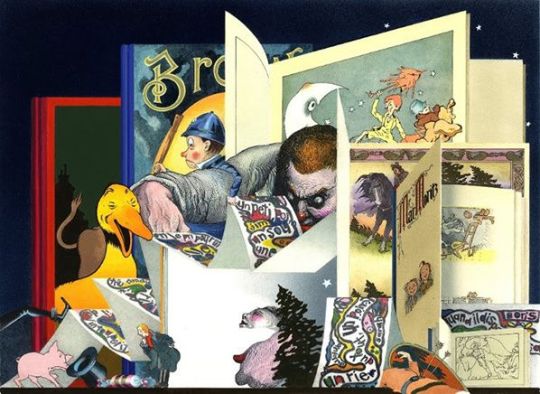
©Béatrice Poncelet

©Catherine Louis, Le Jardin de Madame Li, Picquier, 2016
Au début des années 1990, un drôle de personnage bouleverse bibliothécaires, libraires et parents. J’ai nommé Titeuf ! Bien qu’il fut au départ destiné aux adolescents, les enfants s’en emparent à grande vitesse pour ne plus le quitter. L’illustration romande s’enrichit de nouveaux noms, de nouveaux genres, de l’album illustré à la bande dessinée, en passant par le dessin de presse. Frédéric Pajak monte successivement plusieurs revues avec sa bande : Anna Sommer, Noyau et Mix & Remix. Pour rappel, le couple Anna Sommer/Noyau est l’auteur du très bel album L’Oeuf, paru en 2014 chez Actes Sud BD. Noyau nous conduit à La Lanterne magique, institution incontournable en Suisse. A sa création en 1992, l’artiste est chargé de réaliser son logo et d’illustrer son journal, tâche qu’il accomplit toujours. La Lanterne magique est un ciné-club pour enfants de 6 à 12 ans, né sous l’égide du Centre culturel neuchâtelois. Frédéric Maire, actuel directeur de la Cinémathèque suisse en est le co-fondateur. Rapidement, il essaime des clubs dans toute la Suisse romande, puis partout en Suisse, occupant 75 salles de cinéma une fois par mois, le mercredi après-midi. A l’étranger, 20 pays, dont le Mexique, l’Argentine, le Sénégal, le Maroc, la France, l’Espagne, la Pologne et la Géorgie, y adhèrent. La Lanterne magique marque des générations d’enfants qui se souviendront d’avoir découvert Metropolis, Crin blanc ou Les Temps modernes. Dans la salle, point de popcorn, ni de parents ; les enfants sont confiés à des jeunes gens qui interviennent en cas de besoin pressant ou d’émotions mal contrôlées. Avant le jour J, les jeunes abonnés reçoivent le magazine du club dans lequel le film qui va être projeté est présenté. Et ce n’est pas tout... la séance est introduite par un commentateur, un pianiste, un comédien.
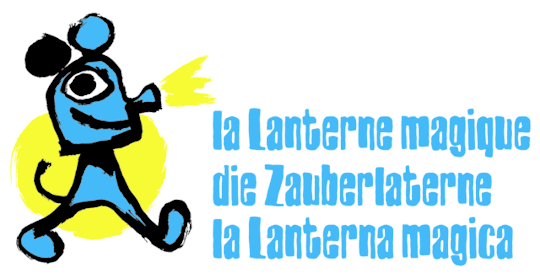
©Logo dessiné par Noyau
La bande dessinée
La bande dessinée n’est pas en reste. La ville de Genève est, à cet égard, très active depuis les années 1970. Des artistes comme Aloys, Gérald Poussin et Exem produisent des affiches politiques et des tracts. Léonore Porchet, historienne de l’art, le constate : « La pratique est à tel point récurrente que le neuvième art devient une image de la politique genevoise et le dessin engagé un débouché incontournable pour la plupart des auteurs genevois. [Plus tard] deux auteurs s’illustrent particulièrement dans ce domaine : Zep et Tom Tirabosco »[2] La maison d’édition Atrabile voit le jour en 1997. Actuellement, elle compte une cinquantaine d’auteur.e.s dont beaucoup sont suisses. Citons Mathieu Baillif (alias Ibn Al Rabin), Alex Baladi (auteur d’un épatant Robinson Suisse), Yannis La Macchia, Frederik Peeters, Isabelle Pralong, Helge Reumann, Nicolas Robel, Tom Tirabosco, Pierre Wazem. Ces auteur.e.s représentent la Suisse lors des festivals. Citons les deux plus importants : BDFIL, à Lausanne, et le Fumetto, à Lucerne.
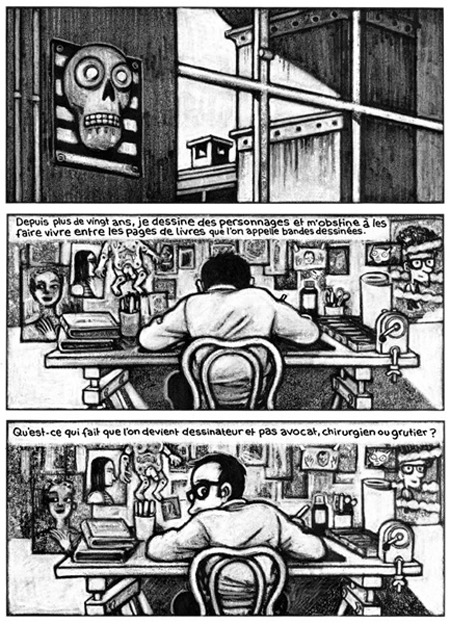
©Tom Tirabosco
Underground par-delà le Graben
Lucerne, située en Suisse allemande, nous offre l’occasion de faire une incursion de l’autre côté de la Sarine. Tout comme en Allemagne, le public germanophone suisse n’a pas la culture de la bande dessinée. Pourtant, en 1984 à Munich, un groupe, formé d’un Luxembourgeois, de deux Allemands et d’un Suisse, crée Strapazin, un périodique dont le modèle est Raw, le magazine publié par Art Spiegelman et Françoise Mouly. Il migre à Zurich dès le second numéro. Il faut savoir que, dès le début des années 1980, les mouvements contestataires de jeunes se multiplient à Zurich, Berne, Lausanne, et avec le mouvement punk. Les fanzines fleurissent. Plus tard, après la chute du mur, l’Allemagne de l’Est, avec des auteurs comme ATAK, fait irruption dans le paysage. Strapazin ouvre largement ses portes au dessin alternatif, qu’il provienne de l’étranger, de la partie alémanique ou romande. C’est ainsi que Tardi, Munoz et Sampayo, Loustal, et plus proche de chez nous, Mix & Remix, Pajak, Anna Sommer, Noyau, Thomas Ott ont participé à une aventure qui aujourd’hui perdure. Mais n’allez pas croire que les quelques Suisses allemands qui font de la BD en vivent ! Et la bande dessinée n’y est toujours pas populaire. Le Fumetto et le Comics Museum de Bâle font donc figure de paradoxe, même s’ils s’adressent plutôt à un public attiré par la « grande » BD.
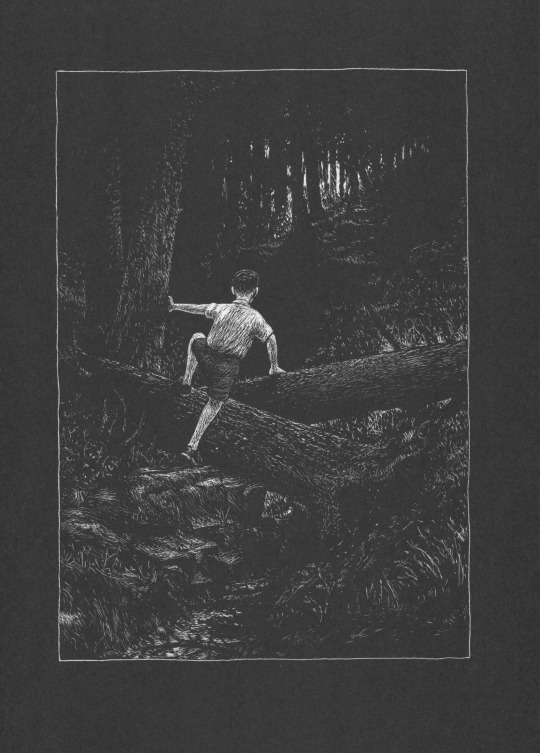
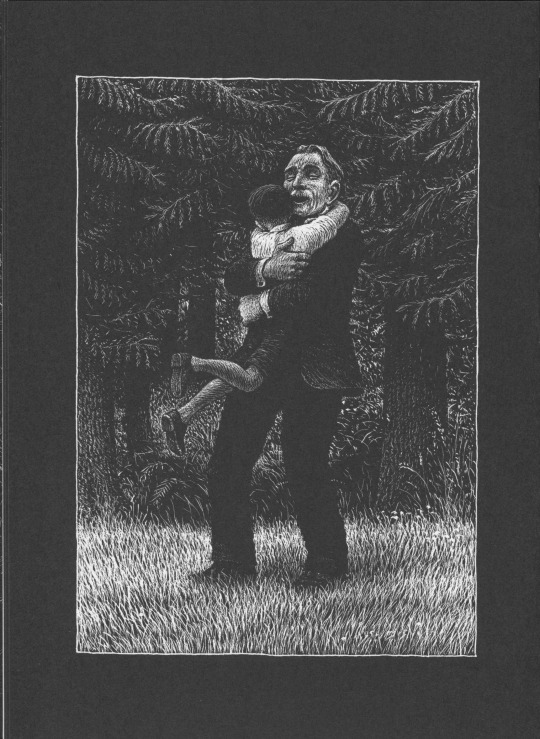
©Thomas Ott, La Forêt, Martin de Halleux, 2020
S’exporter pour survivre
Grâce à ses idées, au talent de ses illustrateurs.trices et à la qualité de ses quelques maisons d’édition, la Romandie joue dans la cour des grands. Sa taille réduite - et donc fragile – et l’obligation de sortir des frontières et d’élargir son marché la poussent à l’excellence. Ses illustrateurs.trices vivent parfois à l’étranger et y publient souvent, notamment en France et en Belgique. Le cas échéant, ils n’ont pu faire d’études d’art que hors les murs car nos écoles ont longtemps ignoré ou, pire, méprisé l’illustration. Leur liste est longue et nous n’en citerons que quelques-uns. Catherine Louis est entrée à l’Ecole des Arts décoratifs de Strasbourg (atelier de Claude Lapointe) ; Irène Schoch a été élève de l’Ensaama à Paris, puis des Arts décoratifs de Strasbourg ; Mirjana Farkas a choisi l’Espagne et l’Escola Massana ; Léonie Bischoff a étudié à l’ESA Saint-Luc de Bruxelles. Léonie, auteure de Anaïs Nin : sur la mer des mensonges, primé au Festival d’Angoulême en 2021, est restée à Bruxelles. Elle fait partie de ceux qui ont choisi de faire leur vie à l’étranger. Ainsi, Ronald Curchod s’est installé à Toulouse. Pour autant, la Suisse n’est pas loin quand, dans Gladys, il se penche sur ses souvenirs familiaux et l’enfance de sa mère dans les montagnes suisses.
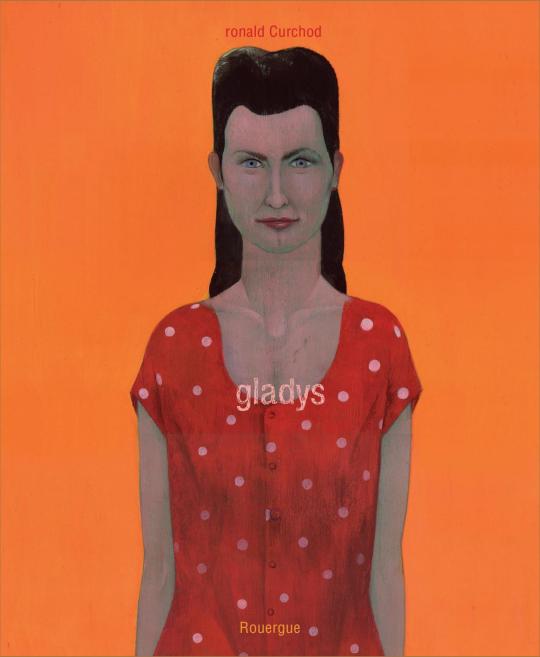
©Ronald Curchod, Gladys, Rouergue, 2020
Est-ce pour ces raisons qu’on peine à trouver un style romand et encore plus des thèmes régionaux, folkloriques ; sauf quand, dans son atelier bruxellois, Fanny Dreyer dessine une poya (montée à l’alpage) et sort La Colonie de vacances, avec des vacances... ou encore la Française ( !) Jacqueline Delaunay fait un livre sur les vaches du Val d’Hérens à la Joie de lire ? Il sera intéressant d’observer l’évolution des choses puisque, d’une part, des écoles forment désormais à l’illustration et que, d’autre part, elles ont un caractère international. Pour l’instant et depuis toujours, on note un côté singulier, parfois précurseur, chez nos illustrateurs.trices, une absence « d’école » commune qui pousse à l’audace chez l’un, à l’expérimentation chez l’autre. Et si dénominateur commun il y a, c’est bien dans la qualité de leur travail. Il n’existe pas ou peu d’illustration de piètre qualité en Suisse romande.
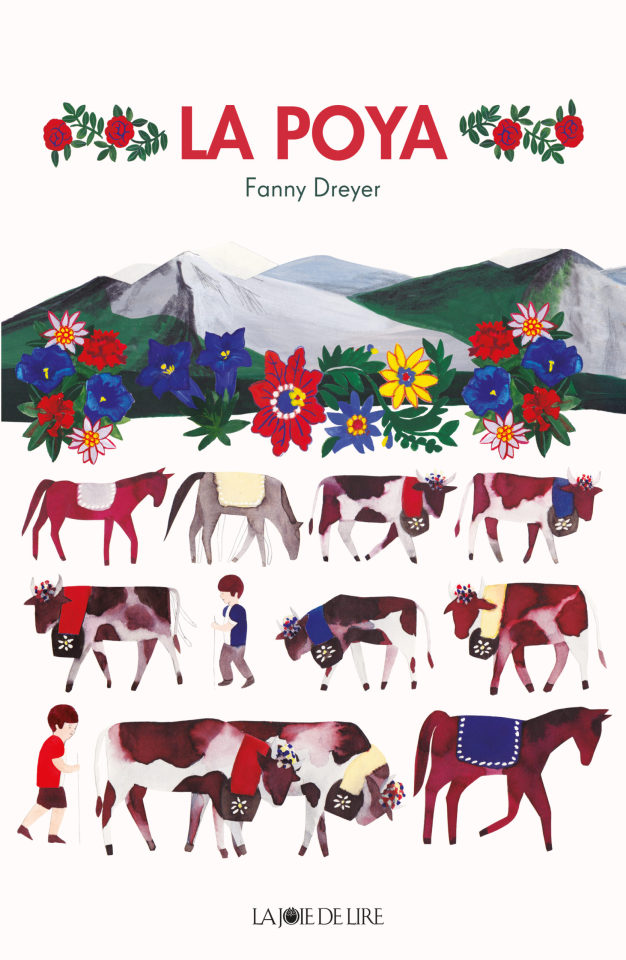
©Fanny Dreyer
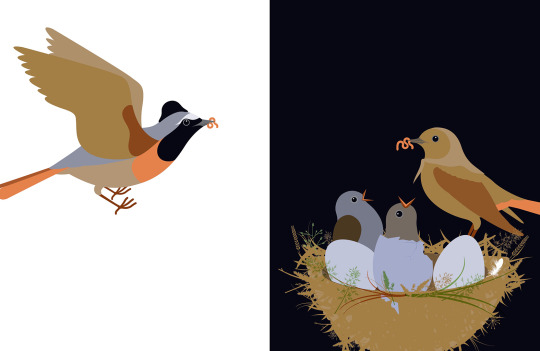
©Anne Crausaz, illustration tirée de Rouge-queue, MeMo, 2020
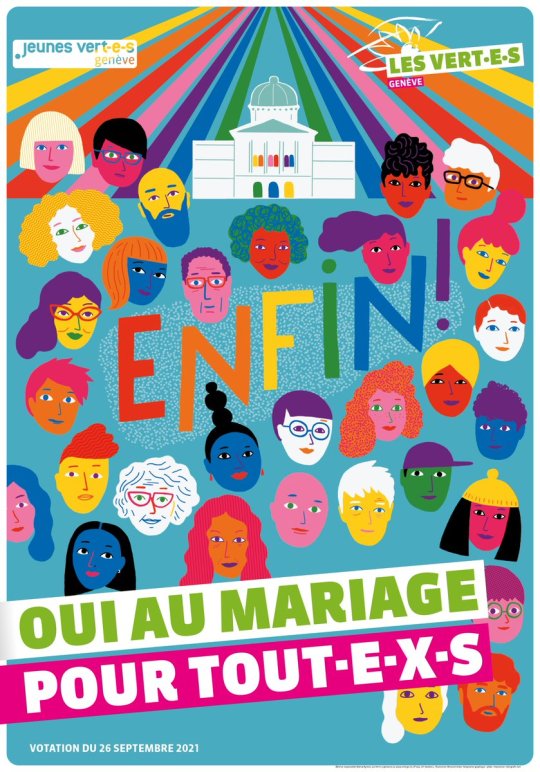
©Mirjana Farkas
L’écriture
Reste à aborder le roman. Et ce n’est pas la moindre affaire : on a beau tourner la question dans tous les sens, chercher encore et encore, le roman jeunesse est quasiment absent. Pourtant, nous avons, en littérature générale, de bons auteurs romands et alémaniques. Notre littérature est souvent exigeante et nous comptons également un auteur de best-sellers, Joël Dicker, et quelques auteurs de polars reconnus.
En matière de jeunesse, existe-t-il une relève après Corinna Bille et ses contes ? Christophe Gallaz a bien écrit Rose-Blanche et Anne-Lise Grobéty Le Temps des mots à voix basse, mais ces deux et quelques autres n’y ont fait qu’une incursion. A l’heure actuelle, les auteur.e.s jeunesse se comptent sur les doigts de la main. Depuis une dizaine d’années, Sylvie Neeman fait un joli parcours et a été remarquée dès son premier album, Mercredi à la librairie, illustré par Olivier Tallec - d’autres ont suivi avec régularité et toujours appréciés. Car sa langue, délicate et poétique, reste toujours à hauteur d’enfant, c’est à dire très haut. Elle qui aime la mer s’est récemment lancée à l’eau en écrivant un roman pour pré-adolescents paru ce printemps, Les Mystères du temps. Marie-Christophe Ruata-Arn écrit depuis une quinzaine d’années. Elle se plaît à bâtir, souvent pour les 10-13 ans, des romans vivants, dont les héroïnes, pour la plupart, sont ancrées dans la réalité. Quant à Germano Zullo, on ne le présente plus puisqu’il fait la paire avec Albertine et qu’ils ont à eux deux quantité d’albums à leur actif. Germano est également l’auteur de deux romans pour adolescents, de nouvelles érotiques et de recueils de poèmes. Leur éditrice, Francine Bouchet, serait peut-être à même de donner d’autres noms, étant sans doute à la recherche de nouveaux talents.

©Albertine Zullo, couverture du catalogue Illustrators Annual 2021 (Bologna Children’s Book Fair)
Il est difficile de trouver des raisons à cette quasi absence d’écrivain.e.s. Mon hypothèse est que nous maîtrisons moins bien la langue française, la culture des jeux de mots, héritée des salons du XVIIIe siècle que nos voisins français. Notre vocabulaire n’est décidément pas aussi riche que le leur et notre débit parfois plus lent, hésitant. L’éloquence – pour ne pas dire le bagou - nous manque. Pire, nous en faisons un complexe. En revanche, si la France est la société du verbe, la Romandie est celle de l’écoute. Il n’est qu’à entendre les propos élogieux des Français invités à la Radio romande pour des entretiens. En fin d’émission, il est courant qu’ils louent la qualité des questions posées et l’écoute des réponses, sans que la parole soit coupée.
La Suisse, composée de majorités ou minorités qui s’entrecroisent, de religions et de langues, est à l’opposé du jacobinisme français. En Suisse allemande, les gens parlent des dialectes très différents d’un canton à l’autre et pour la plupart d’entre eux, l’allemand est considéré comme une langue étrangère apprise à l’école. Pas plus qu’il n’y a de dénominateur commun, il n’existe de caractéristique suisse. La caractéristique est peut-être bien de ne pas en avoir ! Demandez à un Suisse le nom du président de la Confédération, il restera probablement bouche bée.
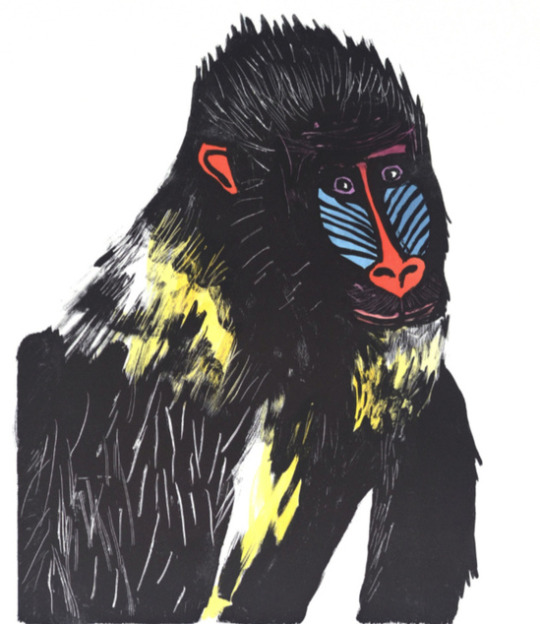
©Irène Schoch, Mandrill, gravure, feuille annuelle Officina Helvetica, 2020
Bien sûr, il existe des projets nationaux auxquels nous nous plions, mais pas toujours de bonne grâce. Nous préférons faire les choses en douceur, aller à la découverte de l’autre en toute sympathie et au gré de nos envies. En la matière, l’approche de PictoBello est un exemple d’ouverture. Chaque année, au mois de juin, ce festival d’illustration expose en plein air dans la ville de Vevey des panneaux de format F12 réalisés par des illustrateurs et des illustratrices venant de toute la Suisse et de pays voisins. Durant une journée, les artistes dessinent sous l’œil des passants. Des espaces librairie sont installés où l’on peut se procurer leurs livres et se les faire dédicacer. Les œuvres, éphémères – et c’est la beauté de la chose -, peuvent être vues durant trois semaines. En 2021, Edmond Baudoin, invité d’honneur, est accompagné de vingt autres artistes. Et cela ne s’arrête pas là ; la langue n’étant pas une barrière pour Valentine Paley, sa directrice, ni pour Jana Jakubek, celle du Fumetto, chaque année il piccolo « PictoBello goes to Fumetto[3] » ! Et en retour, il accueille ein Künstler oder eine Künstlerin des Fumetto. Une belle façon de faire lien et de clore l’article.
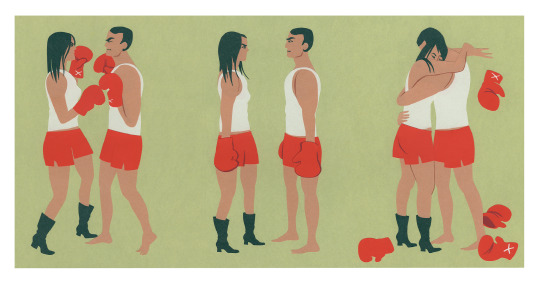
©Anna Sommer. Invitée d’honneur de PictoBello en 2019 et marraine de la collection PictoBella (fonds de bd d’auteures de la Bibliothèque municipale de Vevey
[1] La “frontière de rösti” : le rösti est une galette de pommes de terre que l’on mange volontiers en Suisse allemande.
[2] “Genève : de la politique en bulle”. Bédéphile, no 2, 2016
[3] Les germanophones, cela nous amuse, nous Romands, ont tendance a émailler leurs phrases de mots anglais, voire d’expressions. Parfois même, dans certaines réunions de travail et pour éviter que l’une ou l’autre des langues soit favorisée, l’anglais est utilisé. Sinon, on a pour habitude de parler chacun dans la langue.
NB: L’article original et celui de Dominique Dirlewanger, “La Suisse, juste une mise au point” sont disponibles sur demande dans leur version PDF.
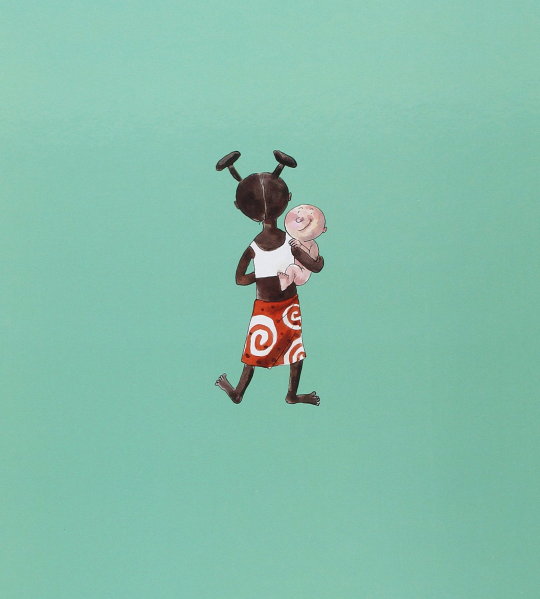
©Anne Wilsdorf, Jujube, Kaléidoscope, 1998
0 notes
